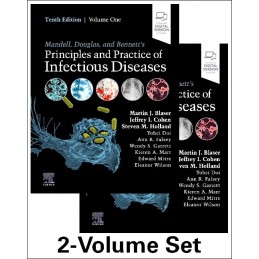- Reduced price
- New

Order to parcel locker

easy pay


 Delivery policy
Delivery policy
Choose Paczkomat Inpost, Orlen Paczka, DHL, DPD or Poczta Polska. Click for more details
 Security policy
Security policy
Pay with a quick bank transfer, payment card or cash on delivery. Click for more details
 Return policy
Return policy
If you are a consumer, you can return the goods within 14 days. Click for more details
Data sheet
I Basic Principles in the Diagnosis and Management of Infectious Diseases
A Microbial Pathogenesis
1 A Molecular Perspective of Microbial Pathogenicity
2 The Human Microbiome
3 Prebiotics, Probiotics, and Synbiotics
B Host Defense Mechanisms
4 Innate (General or Nonspecific) Host Defense Mechanisms
5 Adaptive Immunity: Antibodies and Immunodeficiencies
6 Cell-Mediated Defense Against Infection
7 Mucosal Immunity
8 Granulocytic Phagocytes
9 Complement and Deficiencies
10 Human Genetics and Infection
11 Nutrition, Immunity, and Infection
12 Evaluation of the Patient With Suspected Immunodeficiency
C Epidemiology of Infectious Disease
13 Principles of Applied Epidemiology for the Practice of Infectious Diseases
14 Emerging and Reemerging Infectious Disease Threats
15 Bioterrorism: An Overview
D Clinical Microbiology
16 The Clinician and the Microbiology Laboratory: Test Ordering, Specimen Collection, and Result Interpretation
E Anti-infective Therapy
17 Principles of Anti-infective Therapy
18 Molecular Mechanisms of Antibiotic Resistance in Bacteria
19 Pharmacokinetics and Pharmacodynamics of Anti-infective Agents
20 Penicillins and ?-Lactamase Inhibitors
21 Cephalosporins and Cephalosporin/ ?-Lactamase Inhibitor Combinations
22 Carbapenems, Carbapenem/ ?-Lactamase Inhibitor Combinations, and Aztreonam
23 Antibiotic Allergy
24 Aminoglycosides
25 Tetracyclines, Tetracycline Derivatives, and Chloramphenicol
26 Rifamycins
27 Metronidazole
28 Macrolides and Clindamycin
29 Glycopeptides (Vancomycin and Teicoplanin) and Lipoglycopeptides (Telavancin, Oritavancin, and Dalbavancin)
30 Streptogramins (Quinupristin-Dalfopristin) and Lipopeptides (Daptomycin)
31 Polymyxins (Polymyxin B and Colistin)
32 Linezolid, Tedizolid, and Other Oxazolidinones
33 Sulfonamides and Trimethoprim; Trimethoprim-Sulfamethoxazole
34 Quinolones
35 Antibiotics in Advanced Development and Other Agents
36 Urinary Tract Agents: Nitrofurantoin, Fosfomycin, and Methenamine
37 Topical Antibacterials
38 Antimycobacterial Agents
39 Bacteriophage Therapy, Endolysin Therapy, and Antimicrobial Peptide Therapy
40 Antifungal Agents: Polyene Antifungals
41 Antifungal Drugs: Azole
42 Antifungal Drugs: Echinocandins and Other Beta-d-Glucan Inhibitors
43 Antifungal Drugs: Flucytosine
44 Antimalarial Drugs
45 Drugs for Protozoal Infections Other Than Malaria
46 Drugs for Helminths
47 Antiviral Agents: General Principles
48 Antiviral Drugs for Influenza and Other Respiratory Virus Infections Except for SARS-CoV-2
49 Antivirals Against Herpesviruses
50 Antiviral Drugs Against Hepatitis Viruses
51 Miscellaneous Antiviral Agents (Interferons, Tecovirimat, Imiquimod, Pocapavir)
52 Immunomodulators
53 Hyperbaric Oxygen
54 Antibiotic Stewardship
55 Designing and Interpreting Clinical Studies in Infectious Diseases
56 Outpatient Parenteral Antimicrobial Therapy
II Major Clinical Syndromes
A Fever
57 Temperature Regulation and the Pathogenesis of Fever
58 Fever of Unknown Origin
59 The Acutely Ill Patient With Fever and Rash
B Upper Respiratory Tract Infections
60 The Common Cold
61 Pharyngitis
62 Acute Laryngitis
63 Otitis Externa, Otitis Media, and Mastoiditis
64 Sinusitis
65 Epiglottitis
66 Infections of the Oral Cavity, Neck, and Head
C Pleuropulmonary and Bronchial Infections
67 Acute Bronchitis
68 Acute Exacerbations of Chronic Obstructive Pulmonary Disease
69 Acute Pneumonia
70 Pleural Effusion and Empyema
71 Bacterial Lung Abscess
72 Chronic Pneumonia
73 Cystic Fibrosis
D Urinary Tract Infections
74 Urinary Tract Infections
E Sepsis
75 Sepsis and Septic Shock
F Intraabdominal Infections
76 Peritonitis and Intraperitoneal Abscesses
77 Infections of the Liver and Biliary System (Liver Abscess, Cholangitis, Cholecystitis)
78 Pancreatic Infection
79 Splenic Abscess
80 Appendicitis
81 Diverticulitis and Neutropenic Enterocolitis
G Cardiovascular Infections
82 Endocarditis and Intravascular Infections
83 Prosthetic Valve Endocarditis
84 Infections of Nonvalvular Cardiovascular Devices
85 Prevention of Infective Endocarditis
86 Myocarditis and Pericarditis
87 Mediastinitis
H Central Nervous System Infections
88 Approach to the Patient With Central Nervous System Infection
89 Acute Meningitis
90 Chronic Meningitis
91 Encephalitis
92 Brain Abscess
93 Subdural Empyema, Epidural Abscess, and Suppurative Intracranial Thrombophlebitis
94 Cerebrospinal Fluid Shunt and Drain Infections
I Skin and Soft Tissue Infections
95 Cellulitis, Necrotizing Fasciitis, and Subcutaneous Tissue Infections
96 Myositis and Myonecrosis
97 Lymphadenitis and Lymphangitis
J Gastrointestinal Infections and Food Poisoning
98 Syndromes of Enteric Infection
99 Esophagitis
100 Diarrhea With Little or No Fever
101 Acute Dysentery Syndromes (Diarrhea With Fever)
102 Typhoid Fever, Paratyphoid Fever, and Typhoidal Fevers
103 Foodborne Disease (Food Poisoning)
104 Tropical Sprue and Environmental Enteric Dysfunction
K Bone and Joint Infections
105 Infectious Arthritis of Native Joints
106 Osteomyelitis
107 Orthopedic Implant-Associated Infections
L Diseases of the Reproductive Organs and Sexually Transmitted Diseases
108 Anogenital Skin and Mucous Membrane Lesions
109 Urethritis
110 Vulvovaginitis and Cervicitis
111 Infections of the Female Pelvis
112 Prostatitis, Epididymitis, and Orchitis
M Eye Infections
113 Introduction to Eye Infections
114 Microbial Conjunctivitis
115 Microbial Keratitis
116 Endophthalmitis
117 Infectious Causes of Uveitis
118 Periocular Infections
N Hepatitis
119 Viral Hepatitis
O Acquired Immunodeficiency Syndrome
120 Human Immunodeficiency Viruses
121 Global Perspectives on Human Immunodeficiency Virus Infection and AIDS
122 Epidemiology and Prevention of AIDS and HIV Infection, Including Preexposure Prophylaxis and HIV Vaccine Development
123 Diagnosis of Human Immunodeficiency Virus Infection
124 The Immunology of HIV-1 Infection, Mechanisms of Viral Persistence, and Prospects for Cure
125 General Clinical Manifestations of Human Immunodeficiency Virus Infection
126 Pulmonary Manifestations of Human Immunodeficiency Virus Infection
127 Gastrointestinal, Hepatobiliary, and Pancreatic Manifestations of Human Immunodeficiency Virus Infection
128 Neurologic Diseases Caused by Human Immunodeficiency Virus Type 1 and Opportunistic Infections
129 Pediatric Human Immunodeficiency Virus Infection
130 Antiretroviral Therapy for Human Immunodeficiency Virus Infection
131 Management of Opportunistic Infections Associated With Human Immunodeficiency Virus Infection
P COVID-19
132 Severe Acute Respiratory Syndrome Coronavirus 2 (SARS-CoV-2) Virology
133 Global Perspective and Epidemiology of COVID-19
134 Immunology and Diagnosis of SARS-CoV-2 and COVID-19
135 Clinical Manifestations of COVID-19 in Adults and Children
136 Treatment and Prevention of SARS-CoV-2 (COVID-19)
Q Miscellaneous Syndromes
137 Myalgic Encephalomyelitis/Chronic Fatigue Syndrome
III Infectious Diseases and Their Etiologic Agents
A Viral Diseases
138 Biology of Viruses and Viral Diseases
139 Orthopoxviruses: Vaccinia (Smallpox Vaccine), Variola (Smallpox), Mpox, and Cowpox
140 Other Poxviruses That Infect Humans: Parapoxviruses (Including Orf Virus), Molluscum Contagiosum, and Yatapoxviruses
141 Introduction to Herpesviridae
142 Herpes Simplex Virus
143 Chickenpox and Herpes Zoster (Varicella-Zoster Virus)
144 Cytomegalovirus
145 Epstein-Barr Virus (Infectious Mononucleosis, EBV-Associated Malignant Diseases, and Other Diseases)
146 Human Herpesvirus Types 6 and 7 (Exanthem Subitum)
147 Kaposi Sarcoma-Associated Herpesvirus (Human Herpesvirus 8)
148 Herpes B Virus
149 Adenoviruses
150 Papillomaviruses
151 JC, BK, and Other Polyomaviruses: Progressive Multifocal Leukoencephalopathy, BK Nephropathy, and Merkel Cell Carcinoma
152 Hepatitis B Virus
153 Hepatitis D Virus
154 Human Parvoviruses, Including Parvovirus B19, Human Bocaviruses, and Adeno-Associated Viruses (AAVs)
155 Orthoreoviruses and Orbiviruses
156 Coltiviruses (Colorado Tick Fever Virus) and Seadornaviruses
157 Rotaviruses
158 Alphaviruses
159 Rubella Virus (German Measles)
160 Flaviviruses
161 Hepatitis C
162 Coronaviruses, Including SARS and MERS
163 Parainfluenza Viruses
164 Mumps Virus
165 Respiratory Syncytial Virus
166 Human Metapneumovirus
167 Measles Virus (Rubeola)
168 Zoonotic Paramyxoviruses: Nipah, Hendra, and Pararubulaviruses
169 Vesicular Stomatitis Virus and Related Vesiculoviruses (Chandipura Virus)
170 Rabies (Rhabdoviruses)
171 Marburg and Ebola Virus Diseases
172 Influenza Viruses, Including Avian and Swine Influenza
173 Bunyavirus Infections: Hantavirus Syndromes, La Crosse Encephalitis, Rift Valley Fever, Crimean-Congo Hemorrhagic Fever, and Others
174 Lymphocytic Choriomeningitis Virus, Lassa Virus, Lujo Virus, and Other Hemorrhagic Fever Viruses (Arenaviruses)
175 Human T-Lymphotropic Virus
176 Introduction to Human Enteroviruses and Parechoviruses
177 Poliovirus
178 Coxsackieviruses, Echoviruses, and Other Enteroviruses (EV-D68, EV-D70, EV-A71)
179 The Human Parechoviruses
180 Hepatitis A Virus
181 Rhinovirus
182 Noroviruses and Sapoviruses (Caliciviruses)
183 Astroviruses and Picobirnaviruses
184 Hepatitis E Virus
B Prion Diseases
185 Prions and Prion Diseases of the CNS (Transmissible Neurodegenerative Diseases)
C Chlamydial Diseases
186 Chlamydia trachomatis
187 Psittacosis (Due to Chlamydia psittaci)
188 Chlamydia pneumoniae
D Mycoplasma Diseases
189 Mycoplasmoides (Mycoplasma) pneumoniae
190 Genital Mycoplasmas (Mycoplasma genitalium, Mycoplasma hominis, Ureaplasma Species)
E Rickettsioses, Ehrlichioses, and Anaplasmoses
191 Introduction to Rickettsioses, Ehrlichioses, and Anaplasmoses
192 Rickettsia rickettsii and Other Spotted Fever Group Rickettsiae
193 Coxiella burnetii (Q Fever)
194 Rickettsia prowazekii (Epidemic Typhus)
195 Rickettsia typhi (Murine Typhus)
196 Orientia tsutsugamushi (Scrub TYphus)
197 Ehrlichia chaffeensis, Anaplasma phagocytophilum, and Other Anaplasmataceae
F Bacterial Diseases
198 Introduction to Bacteria and Bacterial Diseases
i. Infections Due to Gram-Positive Bacteria
199 Staphylococcus aureus
200 Staphylococcus epidermidis and Other Coagulase-Negative Staphylococci
201 Classification of Streptococci
202 Streptococcus pyogenes (Group A Streptococcus)
203 Nonsuppurative Poststreptococcal Sequelae: Rheumatic Fever and Glomerulonephritis
204 Streptococcus pneumoniae
205 Enterococcus Species, Streptococcus gallolyticus Group, and Leuconostoc Species
206 Streptococcus agalactiae (Group B Streptococci)
207 Viridans Streptococci, Nutritionally Variant Streptococci, and Groups C and G Streptococci
208 Streptococcus anginosus Group
209 Corynebacterium diphtheriae (Diphtheria)
210 Other Coryneform Bacteria and Rhodococci
211 Listeria monocytogenes
212 Bacillus anthracis (Anthrax)
213 Bacillus Species and Related Genera Other Than Bacillus anthracis
214 Erysipelothrix rhusiopathiae
215 Whipple Disease
ii. Infections Due to Gram-Negative Bacteria
216 Neisseria meningitidis
217 Neisseria gonorrhoeae (Gonorrhea)
218 Moraxella catarrhalis, Kingella, and Other Gram-Negative Cocci
219 Vibrio cholerae
220 Other Pathogenic Vibrios
221 Campylobacter jejuni and Related Species
222 Helicobacter pylori and Other Gastric Helicobacter Species
223 Enterobacterales (Enterobacteriaceae)
224 Pseudomonas aeruginosa and Other Pseudomonas Species
225 Stenotrophomonas maltophilia and Burkholderia cepacia Complex
226 Burkholderia pseudomallei and Burkholderia mallei (Melioidosis, Glanders)
227 Acinetobacter Species
228 Salmonella Species
229 Bacillary Dysentery: Shigella and Enteroinvasive Escherichia coli
230 Haemophilus Species, Including H. influenzae and H. ducreyi (Chancroid)
231 Brucellosis (Brucella Species)
232 Francisella tularensis (Tularemia)
233 Pasteurella Species
234 Plague (Yersinia pestis)
235 Yersinia enterocolitica and Yersinia pseudotuberculosis
236 Bordetella pertussis
237 Rat-Bite Fever: Streptobacillus moniliformis and Spirillum minus
238 Legionnaires’ Disease and Pontiac Fever
239 Capnocytophaga Species
240 Bartonella, Including Cat-Scratch Disease
241 Klebsiella granulomatis (Donovanosis, Granuloma Inguinale)
242 Other Gram-Negative and Gram-Variable Bacilli
iii. Infections Due to Spirochetal Bacteria
243 Syphilis (Treponema pallidum)
244 Endemic Treponematoses
245 Leptospira Species (Leptospirosis)
246 Relapsing Fever Caused by Borrelia Species
247 Lyme Disease (Lyme Borreliosis) Due to Borrelia burgdorferi
iv. Infections Due to Anaerobic Bacteria
248 Anaerobic Infections: General Concepts
249 Clostridioides (Clostridium) difficile Infection
250 Tetanus (Clostridium tetani)
251 Botulism (Clostridium botulinum)
252 Diseases Caused by Clostridium
253 Bacteroides, Prevotella, Porphyromonas, and Fusobacterium Species (and Other Medically Important Anaerobic Gram-Negative Bacilli)
254 Anaerobic Cocci and Anaerobic Gram-Positive Nonsporulating Bacilli
v. Infections Due to Acid-Fast Organisms
255 Mycobacterium tuberculosis
256 Leprosy (Mycobacterium leprae)
257 Mycobacterium avium Complex
258 Infections Caused by Nontuberculous Mycobacteria Other Than Mycobacterium avium Complex
259 Nocardia Species
260 Agents of Actinomycosis
G Mycoses
261 Introduction to Mycoses
262 Candida Species
263 Aspergillus Species
264 Agents of Mucormycosis and Entomophthoramycosis
265 Sporothrix schenckii
266 Chromoblastomycosis
267 Mycetoma
268 Cryptococcosis (Cryptococcus neoformans and Cryptococcus gattii)
269 Histoplasma capsulatum (Histoplasmosis)
270 Blastomyces
271 Coccidioides Species
272 Dermatophytosis (Ringworm) and Other Superficial Mycoses
273 Paracoccidioides
274 Uncommon Fungi and Related Species
275 Pneumocystis Species
276 Microsporidiosis
H Protozoal Diseases
277 Introduction to Protozoal Diseases
278 Entamoeba Species, Including Amebic Colitis and Liver Abscess
279 Free-Living Amebae
280 Malaria (Plasmodium Species)
281 Leishmania Species: Visceral, Cutaneous, and Mucosal Leishmaniasis
282 Trypanosoma Species (American Trypanosomiasis, Chagas Disease)
283 Agents of African Trypanosomiasis (Sleeping Sickness)
284 Toxoplasma gondii
285 Giardia lamblia
286 Trichomonas vaginalis
287 Babesia Species
288 Cryptosporidiosis (Cryptosporidium Species)
289 Cyclospora cayetanensis, Cystoisospora belli, Sarcocystis Species, Balantidium coli, and Blastocystis Species
I Diseases Due to Toxic Algae
290 Human Illness Associated With Cyanobacteria and Harmful Algal Blooms, Including Fish and Shellfish Poisoning Syndromes
J Diseases Due to Helminths
291 Introduction to Helminth Infections
292 Intestinal Nematodes (Roundworms)
293 Tissue Nematodes, Including Trichinellosis, Dracunculiasis, and the Filariases
294 Trematodes (Schistosomes and Liver, Intestinal, and Lung Flukes)
295 Tapeworms (Cestodes)
296 Visceral Larva Migrans and Other Uncommon Helminth Infections
K Ectoparasitic Diseases
297 Introduction to Ectoparasitic Diseases
298 Lice (Pediculosis)
299 Scabies
300 Myiasis and Tungiasis
301 Mites, Including Chiggers
302 Ticks, Including Tick Paralysis
L Diseases of Unknown Etiology
303 Kawasaki Disease
IV. Special Problems
A Nosocomial Infections
304 Infection Prevention and Control in Healthcare
305 Disinfection, Sterilization, and Hospital Waste
306 Infections Caused by Percutaneous Intravascular Devices
307 Nosocomial Pneumonia
308 Catheter-Associated Urinary Tract Infection (CAUTI) and CA-AB
309 Transfusion- and Transplant-Transmitted Infections
B Infections in Special Hosts
310 Infections in the Immunocompromised Host: Principles
311 Prophylaxis and Empirical Therapy in Cancer Patients
312 Infections in Hematopoietic Cell Transplantation
313 Infections in Solid Organ Transplant Recipients
314 Infections in Older Adults
315 Infections in Asplenic Patients
316 Infections in Persons Who Inject Drugs
C Surgical- and Trauma-Related Infections
317 Surgical Site Infections and Prophylaxis
318 Burns
319 Infections Following Trauma
320 Bites
D Immunization
321 Principles of Immunization for Public Health
322 Immunizations for Specific Infections
323 Protection of Travelers
324 Infections in Returning Travelers
E Emerging Issues in Infectious Diseases
325 Zoonoses
326 Communicating About Infectious Diseases to the Public
327 Basic Principles in Climate Change and Infectious Diseases
Reference: 92874
Author: John D. Wasnick
International Edition - lower price
Reference: 11811
Author: Piotr Józefowski
Reference: 11810
Author: Ilias Dumas
Podręcznik dla studentów fizjoterapii
Reference: 11812
Author: Żanna Fiodorenko-Dumas
dla studentów fizjoterapii
Reference: 16779
Author: Ewa Zamysłowska-Szmytke
Atlas ćwiczeń
Reference: 17496
Author: Marek Jarema
Seria: W gabinecie lekarza specjalisty
